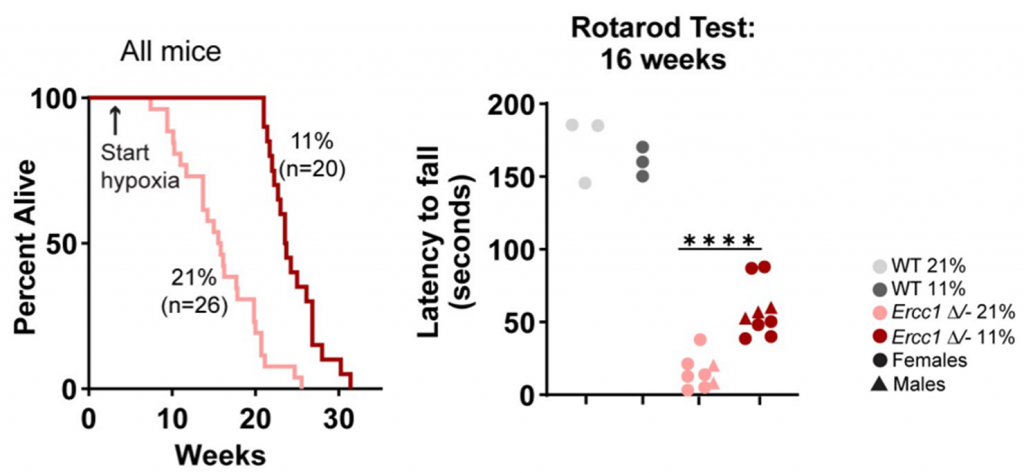Key Points:
- Mice exposed to a low-oxygen environment (11% oxygen) live about 50% longer than mice living in a chamber with normal oxygen levels (21% oxygen).
- Oxygen-restricted mice exhibit enhanced motor coordination.
- The mechanism behind the life-extending effects of hypoxia is unclear and requires further investigation.
Oxygen is the ubiquitous element that exists in nearly all living organisms, continuously influencing energy-producing pathways. In an effort to boost health, scientists developed a treatment known as hyperbaric oxygen therapy (HOT), designed to provide individuals with higher levels of pure oxygen. The research surrounding the health benefits of HOT is still in its infancy; however, some research suggests that oxygen restriction (hypoxia), the opposite of HOT, contributes to longevity.
Now, in a new study published in PLOS Biology, researchers from Harvard Medical School show that an oxygen-restricted environment prolongs the median and maximum lifespan of mice modeling accelerated aging. Additionally, the investigators demonstrate that limiting oxygen intake improves motor coordination.
Notably, lead author Dr. Robert Rogers states, “While caloric restriction is the most widely effective and well-studied intervention to increase lifespan and healthspan, this is the first time that ‘oxygen restriction’ has been demonstrated as beneficial in a mammalian aging model.”
Hypoxia Prolongs Lifespan and Enhances Motor Coordination
Although studies have found that keeping worms, flies, and nematodes in a hypoxic environment promotes increased lifespan, whether these findings translate to mammals has yet to be determined. To shed light on this matter, Rogers and colleagues subjected accelerated aging mice to an environment with 11% circulating oxygen, similar to what’s observed at an altitude of 16,000 feet. Shockingly, the mice kept in the oxygen-restricted chamber lived about 50% longer than those in normal conditions (21 % oxygen, sea level).
The investigators proceeded to examine the effects of hypoxia on neurological function, as reduced oxygen can have profound effects on brain health, namely, memory, cognitive, and motor decline. The Harvard researchers employed the rotor rod test, a behavioral exam assessing motor movements tied to nervous system health. Surprisingly, the results showed that hypoxic mice spent significantly more time on the rotating rod than mice kept in normal oxygen conditions, indicating enhanced motor coordination and neurological function.

How Does Hypoxia Prolong Longevity?
Despite the observed benefits of hypoxia in this mouse model of accelerated aging, the investigators had to pinpoint any other potential factors contributing to these positive results. Given that caloric restriction is one of the few interventions shown to extend the lifespan of multiple model organisms, including the model used in this study, Rogers and colleagues examined whether hypoxia promoted caloric restriction – limiting calories without malnourishment. Accordingly, the findings showed that hypoxia did not affect caloric intake, highlighting that the life-extending effects of hypoxia did not result from caloric restriction.
The Harvard researchers also looked at how hypoxia affected the presence of DNA damage and senescent (aged) cells, two hallmarks of aging. Notably, the mice used in the study lack a gene called Ercc1, which is essential for DNA repair, and this mutation ultimately leads to greater DNA damage and cellular senescence. Moreover, the findings demonstrated no significant differences in DNA damage and cellular senescence between hypoxic mice and aged control mice, suggesting that hypoxia fails to target the two drivers of aging in this particular mouse model.
Although Rogers and colleagues failed to elucidate the mechanism behind oxygen restriction, it’s important to note that results will likely differ using a model of naturally aged mice living in hypoxic conditions. That being said, the current model of accelerated aging provides valuable insight into utilizing oxygen restriction as an aging intervention in mammals.
The Right Amount of Oxygen
Our need for oxygen shifts depending on the situation we’re in. For example, our muscles seek greater amounts of oxygen under extreme physical stress to replenish the energy needed for exertion. Conversely, when at rest, our demand for oxygen is generally lower. It’s still unclear whether continuous exposure to higher or lower amounts of oxygen is beneficial to health. While hypoxia can hinder cellular processes and compromise organ function, having too much oxygen can lead to oxygen toxicity, which increases the production of harmful reactive oxygen species (ROS) that damage tissues. Thus, striking the right balance of oxygen intake is critical to optimizing cellular metabolism and homeostasis.